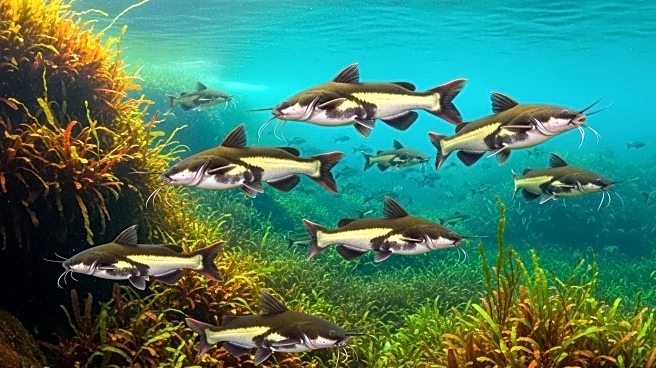What is the story about?
What's Happening?
In the fall of 2024, a remarkable migration of bumblebee catfish was observed near Brazil's Environmental Military Police headquarters. Thousands of these rare catfish, known for their orange bodies with black stripes, climbed the slippery rocks of the Sossego waterfall. Researchers from the Federal University of Mato Grosso do Sul and the Pantanal Biopark witnessed this event, which was later documented in the Journal of Fish Biology. The catfish, typically found individually, were seen in massive numbers, climbing rocks and even researchers' equipment. This behavior is unprecedented for the species, which has a small cavity on its belly aiding in rock adhesion. The migration occurred at night, with the fish emerging from pools and scaling the waterfall. This phenomenon raises questions about the migratory patterns of smaller fish species in Brazilian rivers, challenging the notion that only large fish migrate.
Why It's Important?
The discovery of the bumblebee catfish migration is significant for understanding fish behavior and conservation efforts. It challenges existing beliefs about fish migration, particularly the assumption that only larger species undertake such journeys. This event highlights the need for further research into the migratory patterns of smaller fish species, which could inform conservation strategies. As rivers in the region face damming, understanding these migrations is crucial to prevent disruptions that could threaten the species' survival. The migration also suggests potential breeding behaviors, as fish often move upstream to spawn in safer environments. This insight could lead to better management practices to protect these rare catfish and their habitats.
What's Next?
Researchers are left with numerous questions following the bumblebee catfish migration. They aim to determine if this migration is an annual event and whether other Rhyacoglanis species exhibit similar behaviors. The findings could influence conservation strategies, especially as river damming poses a threat to migratory routes. Further studies are needed to explore the homing behaviors of catfish, which could provide insights into their breeding and survival strategies. The ongoing research will help address the challenges posed by environmental changes and human activities, ensuring the preservation of these unique fish species.
Beyond the Headlines
The bumblebee catfish migration underscores the complexity of aquatic ecosystems and the importance of preserving biodiversity. It highlights the need for ethical considerations in conservation efforts, as human activities like damming can disrupt natural behaviors and threaten species survival. The event also raises cultural questions about the relationship between local communities and their environment, as traditional knowledge of fish migrations can inform scientific research. Long-term shifts in river ecosystems due to climate change and human intervention may further impact these migrations, necessitating adaptive conservation strategies.
AI Generated Content
Do you find this article useful?














